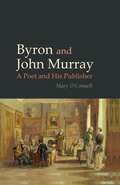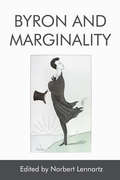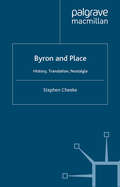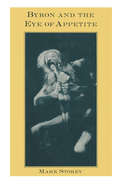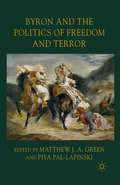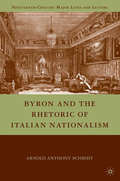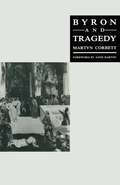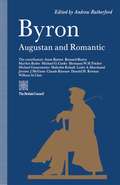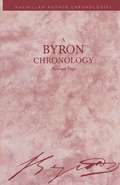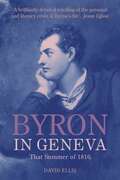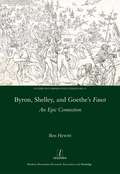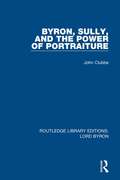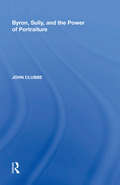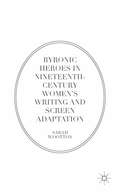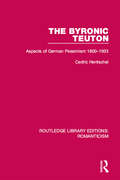- Table View
- List View
Byron and Italy (G - Reference, Information and Interdisciplinary Subjects)
by Alan RawesHow did Italy Italianise Byron? And how did Byron Byronise Italy? These are the key questions that the volume sets out to answer.
Byron and Italy
by Alan RawesHow did Italy Italianise Byron? And how did Byron Byronise Italy? These are the key questions that the volume sets out to answer.
Byron and John Murray: A Poet and His Publisher (Liverpool English Texts and Studies #64)
by Mary O'ConnellByron and John Murray: A Poet and His Publisher is the first comprehensive account of the relationship between Byron and the man who published his poetry for over ten years. It is commonly seen as a paradox of Byron’s literary career that the liberal poet was published by a conservative publishing house. It is less of a paradox when, as this book illustrates, we see John Murray as a competitive, innovative publisher who understood how to deal with his most famous author. The book begins by charting the early years of Murray’s success prior to the publication of Childe Harold’s Pilgrimage, and describes Byron’s early engagement with the literary marketplace. The book describes in detail how Byron became one of Murray’s authors, before documenting the success of their commercial association and the eventual and protracted disintegration of their relationship. Byron wrote more letters to John Murray than anyone else and their correspondence represents a fascinating dialogue on the nature of Byron’s poetry, and particularly the nature of his fame. It is the central argument of this book that Byron’s ambivalent attitude towards professional writing and popular literature can be illuminated through an understanding of his relationship with John Murray.
Byron and Marginality
by Norbert LennartzBrings Ben Jonson to the twenty-first century by reading Volpone through psychoanalysis, poststructuralism and Marxism
Byron and Marginality
by Norbert LennartzOutlines a new critical paradigm for reading children’s Gothic literature and film
Byron and Place: History, Translation, Nostalgia
by S. CheekeThis new study of Byron explores the 'geo-historical' - places where historically significant events have occurred. Cheeke examines the ways in which the notion of being there becomes the central claim and shaping force in Byron's poetry up to 1818. He goes on to explore the concept of being in-between which characterises Byron's 1818-21 poetry. Finally, Byron's complex nostalgia for England, his sense of having been there , is read in relation to a broader critique of memory, home-sickness and place-attachment.
Byron and the Forms of Thought (Liverpool English Texts and Studies #61)
by Anthony HoweAn Open Access edition of this book is available on the Liverpool University Press website and the OAPEN library.Byron and the Forms of Thought is a major new study of Byron as a poet and thinker. While informed by recent work on Byron’s philosophical contexts, the book questions attempts to describe Byron as a philosopher of a particular kind. It approaches Byron, rather, as a writer fascinated by the different ways of thinking philosophy and poetry are taken to represent. After an Introduction that explores Byron’s reception as a thinker, the book moves to a new reading of Byron’s scepticism, arguing for a close proximity, in Byron’s thought, between epistemology and poetics. This is explored through readings of Byron’s efforts both as a philosophical poet and writer of critical prose. The conclusions reached form the basis of an extended reading of Don Juan as a critical narrative that investigates connections between visionary and political consciousness. What emerges is a deeply thoughtful poet intrigued and exercised by the possibilities of literary form.
Byron and the Politics of Freedom and Terror
by Piya Pal-LapinskiThis interdisciplinary collection explores the divergence or convergence of freedom and terror in a range of Byron's works. Challenging the binary opposition of historicism and critical theory, it combines topical debates in a manner that is sensitive both to the circumstances of their emergence and to their relevance for the twenty-first century.
Byron and the Rhetoric of Italian Nationalism (Nineteenth-Century Major Lives and Letters)
by A. SchmidtMaking extensive use of untranslated texts, Arnold Schmidt discusses the impact of Byron's life and works on the discourse of Italian nationalism between 1818 and 1948, his participation in Grand Tour and salon culture, and his influence on Italian Classicists and Romantics.
Byron, Hunt, and the Politics of Literary Engagement (Routledge Studies in Romanticism)
by Michael SteierIn the second decade of the nineteenth century, the British press began a campaign of critical abuse against Leigh Hunt, caricaturing the radical journalist as an upstart "Cockney" author whose literary talents were as disreputable as his politics. Lord Byron, on the other hand, was revered as a peer and a poetical genius who, the conservative press argued, would never befriend and collaborate with a writer like Hunt. Yet Byron did just that. Byron, Hunt, and the Politics of Literary Engagement is the first full-length study of the friendship and literary relationship of two of the most important second-generation Romantic authors. Challenging long-held critical attitudes, this study shows that Byron and Hunt engaged in a creative and meaningful dialogue at each major stage in their careers, from their earliest published volumes of juvenile poetry and verse satire to their most celebrated contributions to Romantic literature: The Story of Rimini and Don Juan. Drawing upon newly recovered letters and unpublished manuscript material, this book illuminates the surprisingly durable and artistically significant friendship of Lord Byron and Leigh Hunt.
Byron, Hunt, and the Politics of Literary Engagement (Routledge Studies in Romanticism)
by Michael SteierIn the second decade of the nineteenth century, the British press began a campaign of critical abuse against Leigh Hunt, caricaturing the radical journalist as an upstart "Cockney" author whose literary talents were as disreputable as his politics. Lord Byron, on the other hand, was revered as a peer and a poetical genius who, the conservative press argued, would never befriend and collaborate with a writer like Hunt. Yet Byron did just that. Byron, Hunt, and the Politics of Literary Engagement is the first full-length study of the friendship and literary relationship of two of the most important second-generation Romantic authors. Challenging long-held critical attitudes, this study shows that Byron and Hunt engaged in a creative and meaningful dialogue at each major stage in their careers, from their earliest published volumes of juvenile poetry and verse satire to their most celebrated contributions to Romantic literature: The Story of Rimini and Don Juan. Drawing upon newly recovered letters and unpublished manuscript material, this book illuminates the surprisingly durable and artistically significant friendship of Lord Byron and Leigh Hunt.
Byron in Geneva: That Summer of 1816
by David EllisIn 1816, following the scandalous collapse of his marriage, Lord Byron left England forever. His first destination was the Villa Diodati by Lake Geneva where he stayed together with Percy Bysshe Shelley, Mary Godwin, Claire Clairmont and John Polidori. Byron in Geneva focuses sharply on the poet’s life in the summer of that year, a famous time for meteorologists (for whom 1816 is the year without a summer), but also that crucial moment in the development of his writing when, urged on by Shelley, Byron tried to transform himself into a Romantic poet of the Wordsworthian variety. The book gives a vivid impression of what Byron thought and felt in these few months after the breakdown of his marriage, but also explores the different aspects of his nature that emerge in contact with a remarkable cast of supporting characters, which also included Madame de Staël, who presided over a famous salon in Coppet, across the lake from Geneva, and Matthew Lewis, author of the splendidly erotic `Gothic’ best-seller, The Monk. David Ellis sets out to challenge recent damning studies of Byron and through his meticulous exploration of the private and public life of the poet at this pivotal moment, he reasserts the value of Byron’s wit, warm-heartedness, and hatred of cant.
Byron: The Poetry of Politics and the Politics of Poetry (Publications of the Centre for Hellenic Studies, King's College London #18)
by Roderick Beaton Christine Kenyon Jones'It is no great matter, supposing that Italy could be liberated, who or what is sacrificed. It is a grand object - the very poetry of politics. Only think - a free Italy!!! Why, there has been nothing like it since the days of Augustus.' So wrote Lord Byron in his journal, in February 1821, only days before the outbreak of revolution in Greece, where three years later he would die in the service of the revolutionary cause. For a poet whose life and work are interlaced with action of multiple sorts, surprisingly little attention has been devoted to Byron's engagement with issues of politics. This volume brings together the work of eminent Byronists from seven European countries and the USA to re-assess the evidence. What did Byron mean by the 'poetry of politics'? Was he, in any sense, a 'political animal'? Can his final, fateful involvement in Greece be understood as the culmination of earlier, more deeply rooted quests? The first part of the book examines the implications of reading and writing as themselves political acts; the second interrogates the politics inherent or implied in Byron's poems and plays; the third follows the trajectory of his political engagement (or non-engagement), from his abortive early career in the British House of Lords, via the Peninsular War in Spain to his involvement in revolutionary politics abroad.
Byron, Shelley and Goethe's Faust: An Epic Connection
by Ben HewittThe first part of Goethe's dramatic poem Faust (1808), one of the great works of German literature, grabbed the attention of Byron and Percy Shelley in the 1810s, engaging them in a shared fascination that was to exert an important influence over their writings. In this comparative study, Ben Hewitt explores the links between Faust and Byron's and Shelley's works, connecting Goethe and the two English Romantic poets in terms of their differing, intricately related experiments with epic. In so doing, Hewitt enters the three writers into a literary and philosophical dialogue concerning 'epic' and 'tragic' perspectives on human knowledge and potential - perspectives crucial to the very structure and significance of Goethe's masterpiece - and illuminates hitherto unacknowledged affinities between these key figures in Romantic literature, and between British and German Romanticisms.
Byron, Shelley and Goethe's Faust: An Epic Connection
by Ben HewittThe first part of Goethe's dramatic poem Faust (1808), one of the great works of German literature, grabbed the attention of Byron and Percy Shelley in the 1810s, engaging them in a shared fascination that was to exert an important influence over their writings. In this comparative study, Ben Hewitt explores the links between Faust and Byron's and Shelley's works, connecting Goethe and the two English Romantic poets in terms of their differing, intricately related experiments with epic. In so doing, Hewitt enters the three writers into a literary and philosophical dialogue concerning 'epic' and 'tragic' perspectives on human knowledge and potential - perspectives crucial to the very structure and significance of Goethe's masterpiece - and illuminates hitherto unacknowledged affinities between these key figures in Romantic literature, and between British and German Romanticisms.
Byron, Sully, and the Power of Portraiture (Routledge Library Editions: Lord Byron)
by John ClubbeFirst published in 2005. Since the early nineteenth century, Byron, the man and his image, have captured the hearts and minds of untold legions of people of all political and social stripes in Britain, Europe, America, and around the world. This book focuses on the history and cultural significance for Federal America of the only portrait of Byron known to have been painted by a major artist. In private hands from 1826 until this day, Thomas Sulley’s Byron has never before been the subject of scholarly study. Beginning with the discovery of the portrait in 1999 and a 200-year narrative of the portrait’s provenance and its relation to other well-known Byron portraits, the author discusses the work within the broad context of British and American portraiture of the late eighteenth and early nineteenth centuries.
Byron, Sully, and the Power of Portraiture (Routledge Library Editions: Lord Byron)
by John ClubbeFirst published in 2005. Since the early nineteenth century, Byron, the man and his image, have captured the hearts and minds of untold legions of people of all political and social stripes in Britain, Europe, America, and around the world. This book focuses on the history and cultural significance for Federal America of the only portrait of Byron known to have been painted by a major artist. In private hands from 1826 until this day, Thomas Sulley’s Byron has never before been the subject of scholarly study. Beginning with the discovery of the portrait in 1999 and a 200-year narrative of the portrait’s provenance and its relation to other well-known Byron portraits, the author discusses the work within the broad context of British and American portraiture of the late eighteenth and early nineteenth centuries.
Byron, Sully, and the Power of Portraiture
by John ClubbeSince the early nineteenth century, Byron, the man and his image, have captured the hearts and minds of untold legions of people of all political and social stripes in Britain, Europe, America, and around the world. This book focuses on the history and cultural significance for Federal America of the only portrait of Byron known to have been painted by a major artist. In private hands from 1826 until this day, Thomas Sully's Byron has never before been the subject of scholarly study. Beginning with his discovery of the portrait in 1999 and a 200-year narrative of the portrait's provenance and its relation to other well-known Byron portraits, the author discusses the work within the broad context of British and American portraiture of the late eighteenth and early nineteenth centuries. Receiving most attention are Thomas Lawrence and Sully, his American counterpart. The author gives the fullest account to date of Sully's career and his relation to English influences and to figures prominent in the early-nineteenth-century American imagination, among them, Washington, Fanny Kemble, Lafayette, Joseph Bonaparte, and Nicholas Biddle. Byron is discussed as an icon of the young American Republic whose Jubilee year coincided with Sully's initial work on the poet's portrait. Later chapters offer a close reading of the portrait, arguing that Sully has given a visual interpretation truly worthy of his celebrated, controversial, and famously handsome subject.
Byron, Sully, and the Power of Portraiture
by John ClubbeSince the early nineteenth century, Byron, the man and his image, have captured the hearts and minds of untold legions of people of all political and social stripes in Britain, Europe, America, and around the world. This book focuses on the history and cultural significance for Federal America of the only portrait of Byron known to have been painted by a major artist. In private hands from 1826 until this day, Thomas Sully's Byron has never before been the subject of scholarly study. Beginning with his discovery of the portrait in 1999 and a 200-year narrative of the portrait's provenance and its relation to other well-known Byron portraits, the author discusses the work within the broad context of British and American portraiture of the late eighteenth and early nineteenth centuries. Receiving most attention are Thomas Lawrence and Sully, his American counterpart. The author gives the fullest account to date of Sully's career and his relation to English influences and to figures prominent in the early-nineteenth-century American imagination, among them, Washington, Fanny Kemble, Lafayette, Joseph Bonaparte, and Nicholas Biddle. Byron is discussed as an icon of the young American Republic whose Jubilee year coincided with Sully's initial work on the poet's portrait. Later chapters offer a close reading of the portrait, arguing that Sully has given a visual interpretation truly worthy of his celebrated, controversial, and famously handsome subject.
Byronic Heroes in Nineteenth-Century Women’s Writing and Screen Adaptation
by Sarah WoottonByronic Heroes in Nineteenth-Century Women's Writing and Screen Adaptation charts a new chapter in the changing fortunes of a unique cultural phenomenon. This book examines the afterlives of the Byronic hero through the work of nineteenth-century women writers and screen adaptations of their fiction. It is a timely reassessment of Byron's enduring legacy during the nineteenth century and beyond, focusing on the charged and unstable literary dialogues between Jane Austen, Elizabeth Gaskell, George Eliot and a Romantic icon whose presence takes centre stage in recent screen adaptations of their most celebrated novels. The broad interdisciplinary lens employed in this book concentrates on the conflicted rewritings of Byron's poetry, his 'heroic' protagonists, and the cult of Byronism in nineteenth-century novels from Pride and Prejudice to Middlemarch, and extends outwards to the reappearance of Byronic heroes on film and in television series over the last two decades.
The Byronic Teuton: Aspects of German Pessimism 1800-1933 (Routledge Library Editions: Romanticism #16)
by Cedric HentschelFirst published in 1940. The Byronic Teuton explores the delineation in German literature, between 1800 and 1933, of certain pessimistic ideas and emotions that were being expressed by writers, artists and academics. This manifestation of negative sentiments was defined by Hentschel as ‘Byronism’. This title will be of interest to students of literature.


